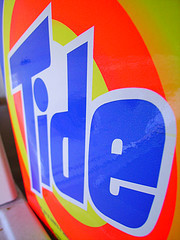How Tide Became An Underground Currency
Ben Paynter investigated the secret detergent economy for New York magazine earlier this month. The lifecycle begins at regular retailers of all kinds, from corner stores to Super Walmarts. We’ve featured many of these Tide heists on the site in the past. It was the police in Prince George’s County, Maryland who decided to go all Lester Freamon on the detergent economy, tracking down and questioning people caught repeatedly on security footage stealing Tide. Who did they sell it to?
Police then staged a sting operation, bringing orange bottles to known buyers, casually mentioning that it was stolen, and handing it over at cut-rate prices.
Tide, a Procter & Gamble product which debuted in 1946, was the first liquid laundry detergent on the market, and has strong cachet and brand recognition for American consumers. “It’s unfortunate that people are stealing Tide, and I don’t think it’s appropriate at all, but the one thing it reminds me of is that the value of the brand has stayed consistent,” the marketing director of Procter & Gamble noted helpfully. That’s true. An item that serves as a currency only retains it value when people want it.
Suds for Drugs [New York Magazine]
RELATED:
Stealing Tide Is Still Enough Of A Problem That This CVS Has Theft-Protection Devices On The Stuff
Cops Bust Tide Detergent Theft Ring Operating Out Of Barber Shop
How To Save On Laundry Without Having To Steal Tide Detergent
Thieves Are Targeting Tide Detergent For Resale On The Black Market
Want more consumer news? Visit our parent organization, Consumer Reports, for the latest on scams, recalls, and other consumer issues.


